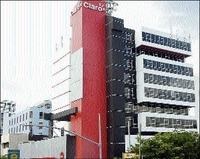Claro's Jamaica entrance did impact Digicel
Published: Sunday | October 11, 2009

The headquarters and New Kingston store of Claro Jamaica is a flashy red. - File
America Movil's (AMX) announced acquisition of Oceanic Digital Jamaica on August 23, 2007, which offered commercial mobile services under the MiPhone brand, sent shock-waves throughout the rest of the Caribbean.
The two main questions centered on whether the Mexico-based operator would impact the Digicel Jamaica operation, and if other markets would follow.
More than two years later, Digicel continues to be the largest mobile operator in Jamaica. AMX local subsidiary Claro Jamaica has not been able to rapidly grow its subscriber base. However, this should not be misinterpreted as if the replacement of MiPhone by Claro did not have an impact on the market, and particularly Digicel.
In order to provide some numbers on how the entrance of AMX changed the competitive scenario, one has to analyse the available statistical information from Digicel.
regional average revenue
For the year ended March 31, 2009, Digicel reported 7.1 million subscribers and US$1.73 billion in revenues - 11 per cent higher than the previous year. This provides a regional average revenue per user or ARPU of around US$20.31
For the year ended on March 31, 2008, Digicel reported 6.54 million subscribers. Estimating revenues 11 per cent lower than reported in March 2009 provides us with US$1.54 billion for a regional ARPU of US$19.62.
As published in Jamaican newspaper reports, Digicel had at least 1.9 million subscribers in Jamaica during 2008.
Signals Telecom Consulting has been tracking prepaid mobile tariffs in the Caribbean for the past several years with the objective of determining rate development in the various markets, placing emphasis on the two leading regional operators: LIME (formerly Cable & Wireless) and Digicel.
model
This is based on a model for the yield in minutes for a top-up of US$10 that has been prepared by Signals, which breaks down the number of minutes originated by users according to time band and the operator network used by the party receiving the call.
Digicel Jamaica's yield in minutes for 1Q08 compared to those for 2Q09 increased 35 per cent in the number of minutes that a subscriber gets for a US$10 recharge.
Also, when contrasting the yield in minutes for 1Q08 and 3Q07, the difference is less than 5.0 per cent.
Now, let us make the following assumptions:
Digicel Jamaica's ARPU is 15 per cent higher than in the rest of the Caribbean.
A yield-per-minute increase of 35 per cent - and taking into account increased usage due to the basic laws of supply and demand - only translates into a 20 per cent decrease in ARPU.
And let us maintain 1.9 million subscribers for both year-end March 2008 and March 2009.
Under this scenario, Digicel Jamaica represented US$514 million in revenues for year-end 2008, approximately one-third of Digicel Group's total revenues.
However, for year end 2009 - after accounting for the 20 per cent ARPU decrease - Digicel Jamaica represented US$426 million in revenues for year end 2009, approximately one-quarter of Digicel Group's total revenues.
To conclude, even if Claro has not been successful in rapidly growing its subscriber base in Jamaica, the increase on competitive pressure is impacting Digicel Jamaica's revenue earnings on this market giving the group a stronger need to expand into other markets.
Josť F. Otero is president of Signals Telecom Consulting, based in Buenos Aires, Argentina. Email: info@signalsconsulting.com















